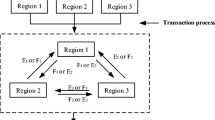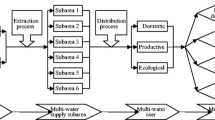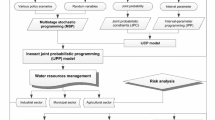Abstract
In this study, a multistage scenario-based interval-stochastic programming (MSISP) method is developed for water-resources allocation under uncertainty. MSISP improves upon the existing multistage optimization methods with advantages in uncertainty reflection, dynamics facilitation, and risk analysis. It can directly handle uncertainties presented as both interval numbers and probability distributions, and can support the assessment of the reliability of satisfying (or the risk of violating) system constraints within a multistage context. It can also reflect the dynamics of system uncertainties and decision processes under a representative set of scenarios. The developed MSISP method is then applied to a case of water resources management planning within a multi-reservoir system associated with joint probabilities. A range of violation levels for capacity and environment constraints are analyzed under uncertainty. Solutions associated different risk levels of constraint violation have been obtained. They can be used for generating decision alternatives and thus help water managers to identify desired policies under various economic, environmental and system-reliability conditions. Besides, sensitivity analyses demonstrate that the violation of the environmental constraint has a significant effect on the system benefit.











Similar content being viewed by others
References
Anderson ML, Mierzwa MD, Kavvas ML (2000) Probabilistic seasonal forecasts of droughts with a simplified coupled hydrologic-atmospheric model for water resources planning. Stoch Environ Res Risk Assess 14(4):263–274
Basağaoğlu H, Mariño MA, Shumwag RH (1999) δ-form approximating problem for a conjunctive water resource management model. Adv Water Resour 23:69–81
Bazaare MS, Bouzaher A (1981) A linear goal programming model for developing economics with an illustration from agricultural sector in Egypt. Manage Sci 27(4):396–413
Birge JR (1985) Decomposition and partitioning methods for multistage stochastic linear programs. Oper Res 33:989–1007
Birge JR, Louveaux FV (1997) Introduction to stochastic programming. Springer, New York
Camacho F, McLeod AI, Hipel KW (1987) Multivariate contemporaneous ARMA model with hydrological applications. Stoch Environ Res Risk Assess 1(2):141–154
Chang NB, Wen CG, Chen YL, Yong YC (1996a) A grey fuzzy multiobjective programming approach for the optimal planning of a reservoir watershed, part A: theoretical development. Water Res 30:2329–2340
Chang NB, Wen CG, Chen YL, Yong YC (1996b) A grey fuzzy multiobjective programming approach for the optimal planning of a reservoir watershed. Part B: application. Water Res 30:2341–2352
Charnes, A, Cooper, WW, Kirby, P (1972) Chance constrained programming: an extension of statistical method. In: Optimizing methods in statistics. Academic Press, New York, pp 391–402
Charnes A, Cooper WW (1983) Response to decision problems under risk and chance constrained programming: dilemmas in the transitions. Manage Sci 29:750–753
Curi RC, Unny TE, Hipel KW, Ponnambalam K (1995) Application of the distributed parameter filter to predict simulated tidal induced shallow water flow. Stoch Environ Res Risk Assess 9(1):13–32
Dupačová J (2002) Applications of stochastic programming: achievements and questions. Eur J Oper Res 140:281–290
Dupačová J, Gaivoronski A, Kos Z, Szantai T (1991) Stochastic programming in water management: a case study and a comparison of solution techniques. Eur J Oper Res 52:28–44
Edirisinghe NCP, Patterson EI, Saadouli N (2000) Capacity planning model for a multipurpose water reservoir with target-priority operation. Ann Oper Res 100:273–303
Ellis JH (1991) Stochastic programs for identifying critical structural collapse mechanisms. Appl Math Model 15:367–379
Gang DC, Clevenger TE, Banerji SK (2003) Modeling chlorine decay in surface water. J Environ Inform 1:21–27
Guo P, Huang GH (2008) Two-stage fuzzy chance-constrained programming: application to water resources management under dual uncertainties. Stoch Environ Res Risk Asses Online, doi: 10.1007/s00477-008-0221-y
Howe B, Maier D, Baptista A (2003) A language for spatial data manipulation. J Environ Inform 2:23–37
Huang GH (1996) IPWM: an interval parameter water quality management model. Eng Optim 26:79–103
Huang GH (1998) A hybrid inexact-stochastic water management model. Eur J Oper Res 107:137–158
Infanger G (1993) Monte Carlo (importance) sampling within a benders decomposition algorithm for stochastic linear programs. Ann Oper Res 39:69–81
Infanger G, Morton DP (1996) Cut sharing for multistage stochastic linear programs with interstage dependency. Math Programm 75:241–251
Jacovkis PM, Gradowczyk H, Freisztav AM, Tabak EG (1989) A linear programming approach to water-resources optimization. Math Methods Oper Res 33(5):341–362
Jairaj PG, Vedula S (2000) Multi-reservoir system optimization using fuzzy mathematical programming. Water Res Manage 14:457–472
Ji JH, Chang NB (2005) Risk assessment for optimal freshwater inflow in response to sustainability indicators in semi-arid coastal bay. Stoch Environ Res Risk Assess 19(2):111–124
Li YP, Huang GH, Nie SL (2006a) An interval-parameter multistage stochastic programming model for water resources management under uncertainty. Adv Water Resour 29:776–789
Li YP, Huang GH, Baetz BW (2006b) Environmental management under uncertainty–an interval-parameter two-stage chance-constrained mixed integer linear programming method. Environ Eng Sci 23(5):761–779
Li YP, Huang GH, Nie SL (2007a) Mixed interval-fuzzy two-stage integer programming and its application to flood-diversion planning. Eng Optimiz 39(2):163–183
Li YP, Huang GH, Nie SL, Qin XS (2007b) ITCLP: an inexact two-stage chance-constrained program for planning waste management systems. Resour Conserv Recycl 49(3):284–307
Li YP, Huang GH, Nie SL, Liu L (2008) Inexact multi-stage stochastic integer programming for water resources management under uncertainty. J Environ Manage 88:93–107
Loucks DP, Stedinger JR, Haith DA (1981) Water resource systems planning and analysis. Prentice-Hall, Englewood Cliffs
Maqsood I, Huang GH, Huang YF, Chen B (2005) ITOM: an interval-parameter two-stage optimization model for stochastic planning of water resources systems. Stoch Environ Res Risk Assess 19:125–133
Morgan DR, Eheart JW, Valocchi AJ (1993) Aquifer remediation design under uncertainty using a new chance constrained programming technique. Water Resour Res 29:551–568
Paudyal GN, Manguerra HB (1990) Two-step dynamic programming approach for optimal irrigation water allocation. Water Resour Manage 4(3):187–204
Pereira MVF, Pinto LMVG (1991) Multistage stochastic optimization applied to energy planning. Math Programm 52:359–375
Rangarajan S (1995) Sustainable planning of the operation of reservoirs for hydropower generation, PhD thesis, Department of Civil Engineering, University of Manitoba, Winnipeg
ReVelle C (1999) Optimizing reservoir resources including a new model for reservoir reliability. Wiley, New York
Russell SO, Campbell PF (1996) Reservoir operating rules with fuzzy programming. ASCE J Water Resour Plann Manage 122:165–170
Seifi A, Hipel KW (2001) Interior-point method for reservoir operation with stochastic inflows. ASCE J Water Resour Plann Manage 127(1):48–57
Sethi LN, Kumar DN, Panda SN, Mal BC (2002) Optimal crop planning and conjunctive use of water resources in a coastal river basin. Water Resour Manage 16:145–169
Slowinski R (1986) A multicriteria fuzzy linear programming method for water supply system development planning. Fuzzy Sets Syst 19:217–237
Srinivasan K, Neelakantan TR, Narayan P (1999) Mixed-integer programming model for reservoir performance optimization. ASCE J Water Res Plann Manage 125(5):298–301
Srinivasan R, Simonovic SP (1994) A reliability programming model for hydropower optimization. Can J Civil Eng 21:1061–1073
Sylla C (1995) A penalty-based optimization for reservoirs system management. Comput Ind Eng 28(2):409–422
Watkins DW Jr, Mckinney DC, Lasdon LS, Nielsen SS, Martin QW (2000) A scenario-based stochastic programming model for water supplies from the highland lakes. Int Transit Oper Res 7:211–230
Zare Y, Daneshmand A (1995) A linear approximation method for solving a special class of the chance constrained programming problem. Eur J Oper Res 80:213–225
Zarghami M, Szidarovszky F (2008) Stochastic-fuzzy multi criteria decision making for robust water resources management. Stoch Environ Res Risk Assess Online (doi: 10.1007/s00477-008-0218-6)
Acknowledgments
This research has been supported by the Natural Science Foundation of China (50849002, 40730633, 40571030), the Major State Basic Research Development Program of China (2003CB415201, 2005CB724200, 2006CB403307), and the Natural Sciences and Engineering Research Council of Canada. The authors are grateful to the editors and the anonymous reviewers for their insightful comments and suggestions.
Author information
Authors and Affiliations
Corresponding author
Appendix 1 Nomenclatures for variables and parameters
Appendix 1 Nomenclatures for variables and parameters
- f ± :
-
net system benefit over the planning horizon ($)
- t :
-
time period, and t = 1, 2,…,T
- \( A_{1}^{0} \) :
-
storage-area coefficient for reservoir 1
- \( A_{2}^{0} \) :
-
storage-area coefficient for reservoir 2
- \( A_{1}^{a} \) :
-
area (per unit of active storage volume) above \( A_{1}^{0} ; \)
- \( A_{2}^{a} \) :
-
area (per unit of active storage volume) above \( A_{2}^{0} ; \)
- \( De_{t}^{ \min } \) :
-
minimum amount of water demand for the municipality in period t (m3)
- \( De_{t}^{ \max } \) :
-
maximum water demand for the municipality in period t (m3)
- e1t :
-
average evaporation rate for reservoir 1 in period t
- e2t :
-
average evaporation rate for reservoir 2 in period t
- \( E_{1t}^{ \pm } \) :
-
evaporation loss of reservoir 1 in period t (m3)
- \( E_{2t}^{ \pm } \) :
-
evaporation loss of reservoir 2 in period t (m3)
- \( K_{1}^{t} \) :
-
number of possible scenarios for stream 1 in period t
- \( K_{2}^{t} \) :
-
number of possible scenarios for stream 2 in period t
- \( NB_{t}^{ \pm } \) :
-
net benefit per unit of water allocated in period t ($/m3)
- \( PE_{t}^{ \pm } \) :
-
penalty per unit of water not delivered in period t ($/m3), and PE t > NB t
- \( p_{{tk_{1} }} \) :
-
probability of occurrence of scenario k 1 (for stream 1) in period t, with \( p_{{tk_{1} }} > 0 \) and \( \sum\limits_{{k_{1} = 1}}^{{K_{1}^{t} }} {p_{{tk_{1} }} = 1} \)
- \( p_{{tk_{2} }} \) :
-
probability of occurrence of scenario k 2 (for stream 2) in period t, with \( p_{{tk_{2} }} > 0 \) and \( \sum\limits_{{k_{2} = 1}}^{{K_{2}^{t} }} {p_{{tk_{2} }} = 1} \)
- \( Q_{{tk_{1} }}^{ \pm } \) :
-
random inflow into stream 1 in period t under scenario k 1 (m3)
- \( Q_{{tk_{2} }}^{ \pm } \) :
-
random inflow into stream 2 in period t under scenario k 2 (m3)
- \( R_{{tk_{1} }}^{ \pm } \) :
-
release flow from reservoir 1 in period t under scenario k 1 (m3)
- \( R_{{tk_{1} k_{2} }}^{ \pm } \) :
-
release flow from reservoir 2 in period t under scenarios k 1 and k 2 associated with joint probabilities of \( p_{{tk_{1} }} p_{{tk_{2} }} \) (m3)
- \( RSC_{1}^{ \pm } \) :
-
storage capacity of reservoir 1 (m3)
- \( RSC_{2}^{ \pm } \) :
-
storage capacity of reservoir 2 (m3)
- \( RSV_{1}^{ \pm } \) :
-
reserved storage level for reservoir 1 (m3)
- \( RSV_{2}^{ \pm } \) :
-
reserved storage level for reservoir 2 (m3)
- \( S_{{tk_{1} }} \) :
-
storage level in reservoir 1 in period t under scenario k 1 (m3)
- \( S_{{tk_{1} k_{2} }} \) :
-
storage level in reservoir 2 in period t under scenarios k 1 and k 2 (m3)
- X t :
-
water allocation target that is promised to the municipality in period t (m3)
- \( Y_{{tk_{1} k_{2} }}^{ \pm } \) :
-
shortage level by which the water-allocation target is not met under scenarios k 1 and k 2 which is associated with joint probabilities of \( p_{{tk_{1} }} p_{{tk_{2} }} \)(m3)
Rights and permissions
About this article
Cite this article
Li, Y.P., Huang, G.H. & Chen, X. Multistage scenario-based interval-stochastic programming for planning water resources allocation. Stoch Environ Res Risk Assess 23, 781–792 (2009). https://doi.org/10.1007/s00477-008-0258-y
Published:
Issue Date:
DOI: https://doi.org/10.1007/s00477-008-0258-y




